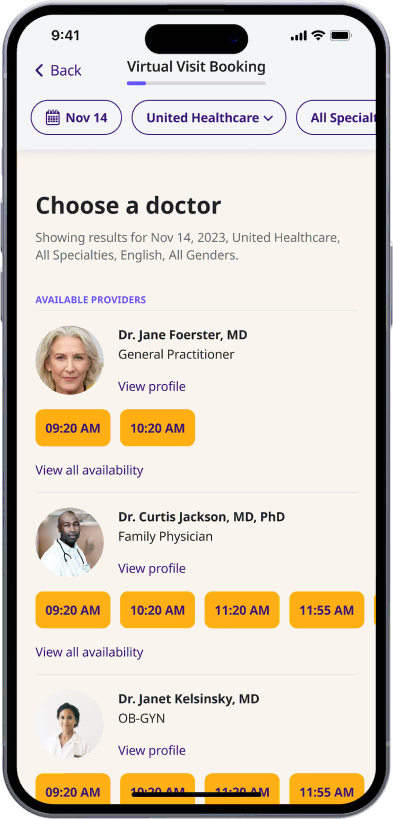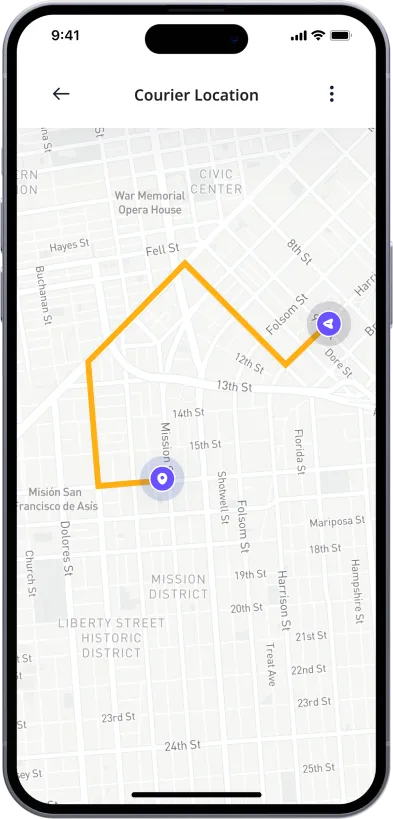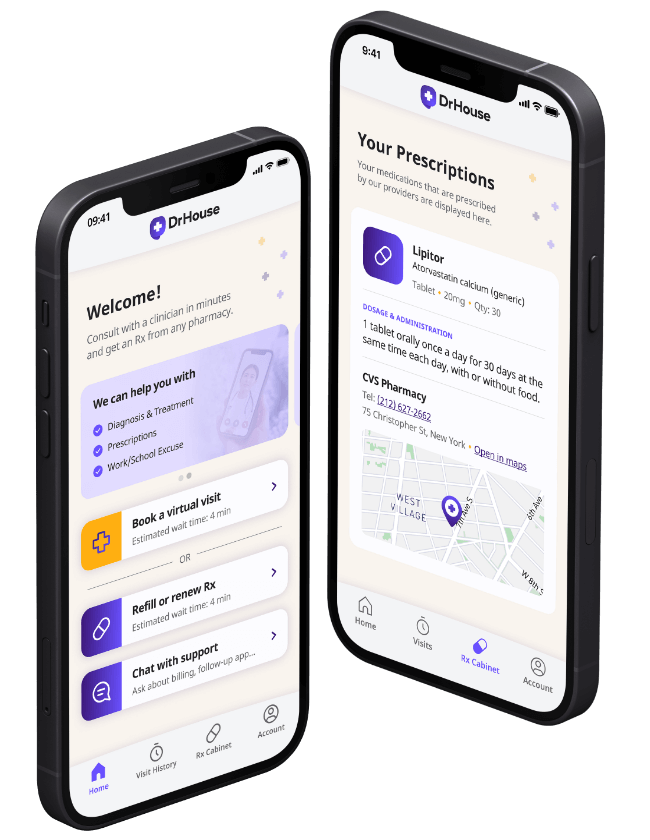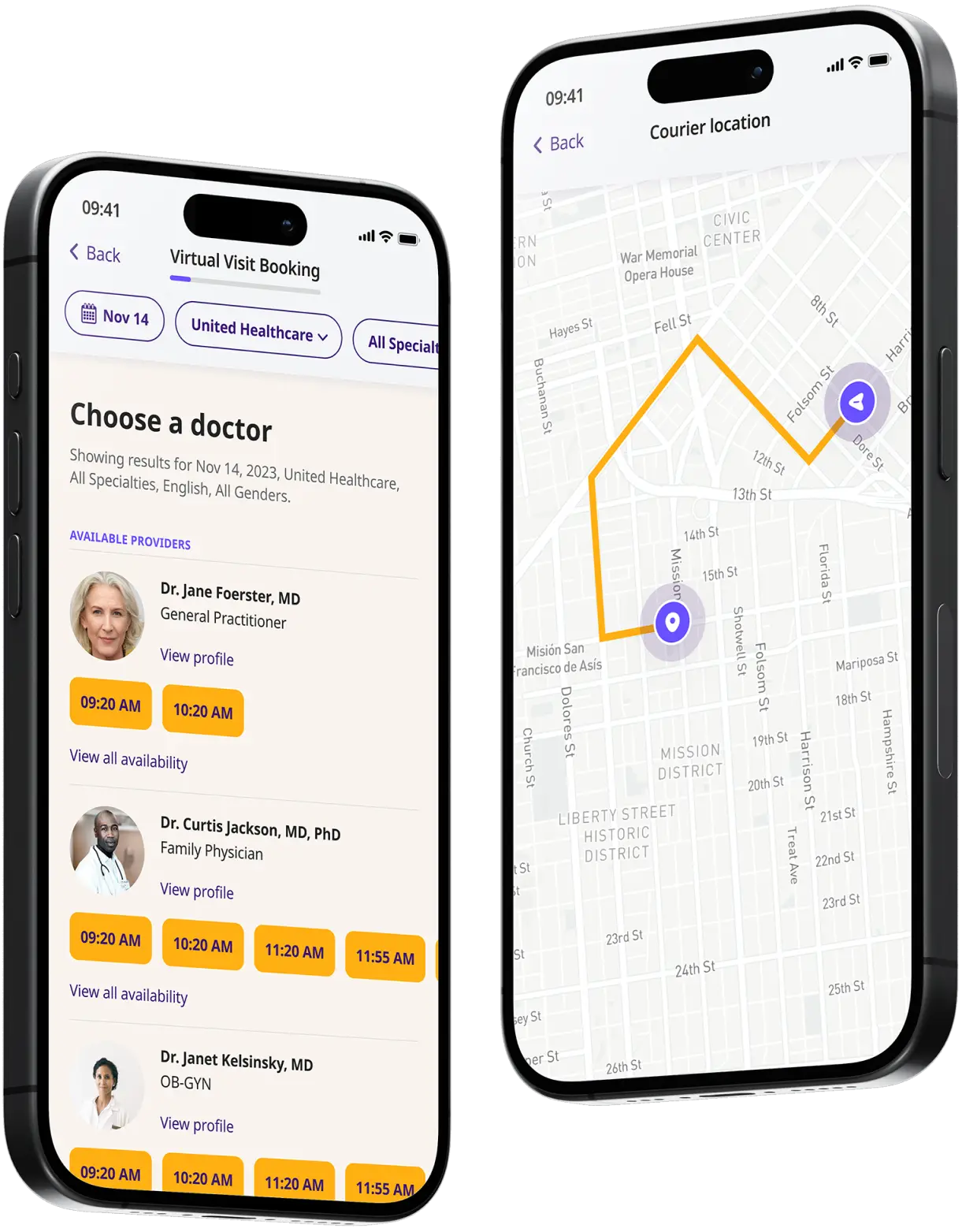Get a Cephalexin Prescription Online
Get a prescription for cephalexin (Keflex) now! Our doctors are available 24/7 in all 50 states.


Available in 50 states. Insurance accepted.
Fast
virtual visits
24/7 care
assistants
Prescriptions
as needed

24/7 Personal Care
Consult with a physician in 15 minutes, refill an Rx or chat with our care assistants.

Affordable & Convenient
See your cost upfront and get treatment for hundreds of different conditions.

Insurance Accepted
We accept most major insurance plans, making healthcare easy and affordable.
See If Delivery Is Available Near You
Delivery Not Available
Enter your ZIP code to check if prescription delivery is available in your area and how soon your meds could arrive.
How to get started
Choose your doctor, start a virtual visit, and have your prescriptions sent to your preferred pharmacy for pickup — all in just a few easy steps.
Choose a doctor
Choose a physician by availability, specialty, ratings, and more.

Start a video call
Get connected with a doctor anytime, anywhere.

Get your prescription
Choose a pharmacy for pickup or have it delivered to your door.

Available in 50 states. Insurance accepted.
One-Time
Physician Visit
One-time visit with a physician for diagnosis, treatment, Rx, labs, referrals, and doctor’s notes.
Accepted Insurances
See why people turn to DrHouse...
As seen in

Cephalexin (Generic Keflex)
What is Cephalexin?
Cephalexin is an antibiotic belonging to the cephalosporin class and is used to treat a range of bacterial infections by killing bacteria. Other cephalosporin antibiotics include cefaclor and cefadroxil.
Cephalexin is available under various brand names, including Keflex, Zartan, Biocef, Daxbia, and Panixine.
Cephalexin comes in a variety of forms, such as capsules, tablets, or liquid suspensions. Capsules and tablets should be stored at room temperature and away from heat, moisture, or light, while those taking a liquid suspension should store it in the refrigerator and throw away anything not used within 14 days.
Cephalexin is considered a broad-spectrum antibiotic, which means it is capable of treating a wider range of bacterial infections and, as such, may be prescribed in cases where a doctor suspects infection from multiple bacterial strains or is unsure of the exact bacteria causing the infection.
How Does Cephalexin Work?
Cephalexin works by impeding the bacteria’s ability to form its cell wall, which is the outer boundary of the bacteria that keeps all of its elements contained.
By interfering with cell wall formation, cephalexin causes the wall to rupture. This occurs because, without the support of a cell wall, the pressure inside the bacteria’s cell becomes too much, and the membrane bursts, killing the bacteria.
What Is Cephalexin Used For?
Cephalexin is considered a broad-spectrum antibiotic, which means it can treat infections resulting from a broad range of bacteria.
Cephalexin may be prescribed to treat bacterial infections such as:
- ear infections
- upper respiratory infections
- urinary tract infections
- skin infections
- bone infections
These are only some of the most common uses for cephalexin; other infections may also benefit from this medication.
As an antibiotic, cephalexin is only helpful against bacterial infections, not those resulting from a virus or a fungus. Taking cephalexin if you have a viral infection such as a cold or the flu will not help you get better quicker and may even harm your immune system and leave you with a worse and longer-lasting illness.
Side Effects of Cephalexin
The most common side effects of cephalexin include:
- nausea
- vomiting
- diarrhea
- vaginal itching or discharge
- indigestion
- stomach pain
These side effects are common but generally mild. However, if any of these symptoms do not go away or become severe, it’s important to contact your doctor.
Some more serious side effects that may occur when taking cephalexin include:
- diarrhea that is bloody or watery
- unusual tiredness
- feeling short of breath or light-headed
- seizures
- easy bruising or red or purple spots under your skin
- fever
- yellowed skin or dark-colored urine
- cold hands and feet
- pain in your lower back or side
Contact a healthcare professional immediately if you experience any of these side effects.
It is also possible to develop an allergic reaction to cephalexin. If you experience symptoms such as difficulty breathing, hives, or swelling of the lips, face, throat, or tongue, seek immediate medical attention.
How to Take Cephalexin?
Cephalexin should be taken exactly as prescribed by your doctor, and this includes the dosing instructions and timing. Additionally, cephalexin should only be taken to treat the condition as assigned by your doctor.
When prescribed cephalexin, take it for the entire prescribed duration, even if your symptoms improve. If your symptoms do not improve within a few days, contact your doctor, as they may want to increase your dosage or place you on a different antibiotic.
The dosage of cephalexin prescribed will vary based on your age, the condition cephalexin is prescribed to treat and its severity, other medical conditions you have, and your body’s reaction to the first dose.
Cephalexin comes in capsules and tablets of 250 mg, 500 mg, or 750 mg. Depending on your situation, your doctor may have you take 1-4 grams per day, and these amounts are usually divided into doses taken every 6-12 hours.
Cephalexin is taken multiple times a day, and adhering to your dosing schedule is essential. If you miss a dose, take the medication as soon as you can, but skip the dose if it is almost time for the next dose. Do not take two doses at once, as it is possible to overdose on cephalexin, with symptoms that include vomiting, nausea, stomach pain, blood in the urine, and diarrhea. If you overdose on cephalexin, contact a doctor or seek emergency medication attention.
Cephalexin can be taken with or without food. If you experience an upset stomach from cephalexin, taking it with food can help mitigate these unpleasant symptoms.
Frequently Asked Questions About Cephalexin
What Should You Avoid While Taking Cephalexin?
While taking cephalexin, your doctor may have you avoid taking metformin or probenecid, as these medications can interact with cephalexin.
However, it’s important to tell your doctor about all medications, supplements, or vitamins that you take so that they can look for other potential interactions.
What Is the Most Common Side Effect of Cephalexin?
The most common side effect reported for cephalexin is diarrhea. Other common side effects include nausea, vomiting, abdominal pain, and indigestion.
The mentioned side effects above are just some of the most common ones associated with cephalexin; other side effects may occur. Speak to your doctor about all the risks of taking this medication.
Also, reach out to your doctor if any of the common side effects don’t go away or if you experience any concerning side effects while taking cephalexin.
How Long Does It Take for Cephalexin to Work?
It’s hard to say exactly how long it will take for cephalexin to work as it varies from person to person and depends on the type and severity of the infection being treated as well as many other different factors.
For common infections, some people may experience relief within 1-2 days of starting cephalexin, while others may take longer to improve.
It’s important to take cephalexin for the full course prescribed by your doctor, even if you feel better after a few days. Failing to do so may result in your infection not being treated properly and therefore returning.
What Is the Typical Dosage for Cephalexin?
Cephalexin comes in capsules and tablets of 250 mg, 500 mg, or 750 mg. Depending on your situation, your doctor may have you take 1-4 grams per day, and these amounts are usually divided into doses taken every 6-12 hours.
It’s important to note that the exact dosage will vary depending on the type of infection being treated, your age, weight, and other medical conditions you may have. Therefore, it is important to only take cephalexin as prescribed by your doctor.
Can You Get Cephalexin (Keflex) Over-The-Counter (OTC)?
No Chephexin is not available over-the-counter (OTC). Cephalexin requires a prescription from a doctor or healthcare provider.
Can I Get Cephalexin (Keflex) Online?
Yes, you can get an online prescription for Cephalexin from DrHouse. DrHouse can connect you with a board-certified doctor who will review your medical history and current condition to determine if Cephalexin is the best treatment option for you.
For more detailed information about cephalexin, you can refer to the following sources:
- Keflex prescription label, Food and Drug Administration (FDA).
- Cephalexin, Drugs.com.
- Cephalexin, MedlinePlus.
The content on this page has been medically reviewed for accuracy and comprehensiveness by Amy Dougherty, FNP-BC, AGAC
Frequently asked questions




